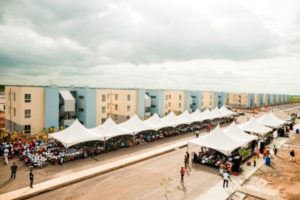Ghana pays far more for Saglemi housing project above initial estimates

When on October 31, 2012, the Ghana Parliament on it’s last meeting day before it adjourned approved the deal for the Saglemi Housing Project initiated by the then government in response to the country’s huge housing deficit, then estimated to be more than 1.7 million, the cost of the units were put at $29,000 for a two bed unit and $57,000 for a three bed unit.
The deal involved a $200 million loan from Credit Suisse International to construct 5,019 affordable housing units by the construction firm, Construtora OAS Limited. The proposed project was to consist of 3,770 two bedroom units and 1,249 three bedroom units.
Credit Suisse gave a grace period of two years before the repayment period of five years and the maturity period of seven years for the loan.
The loan was obtained at an interest rate of 12.5 per cent per annum on the cedi equivalent of the dollar loan amount based on the exchange rate at the time of amount drawdown.
Parliament during the debate indicated that the 12.5 per cent cedi interest rate on the facility was “far lower than the treasury bill rate, hence making the facility very economical.”
But even though the project hasn’t been fully completed, the cost per unit has shot up and the overall value for money does not seem to have been achieved.
A project analysis by a researcher and academic in the built environment, Selorm Adukpo, and shared with Ghana Business News, shows that at $200 million for 5,019 units, the average cost of a unit should be $39, 845.58. However, with only 1,509 units partially completed and an amount of $179,904,755.79 paid to the contractor as at February 2018, there is a rise in average cost per unit to $119,221.18. This translates to an average overrun cost per unit of $79,372.60. Furthermore, whilst almost 90 per cent of the loan amount has been disbursed to the contractor, only 30 per cent of the units have been (partially) completed.
Given the repayment terms of the loan, it also suggests that the government is repaying the loans for a facility it is not using and for which a firm completion date is not assured. This invariably means that the government would have had to resort to another source of funding, either through tax payers contributions or commercial loans, to repay the loans for a project that was dubbed as self-financing by the parliament of Ghana.
Based on this analysis, it means the country has lost more than it has gained from this otherwise good project. The country may want to complete the project ASAP to cut its losses whilst it pursues appropriate avenues to seek clarifications from those who formulated the project
By Emmanuel K. Dogbevi
Copyright ©2021 by NewsBridge Africa
All rights reserved. This article or any portion thereof may not be reproduced or used in any manner whatsoever without the express written permission of the publisher except for the use of brief quotations in reviews.
